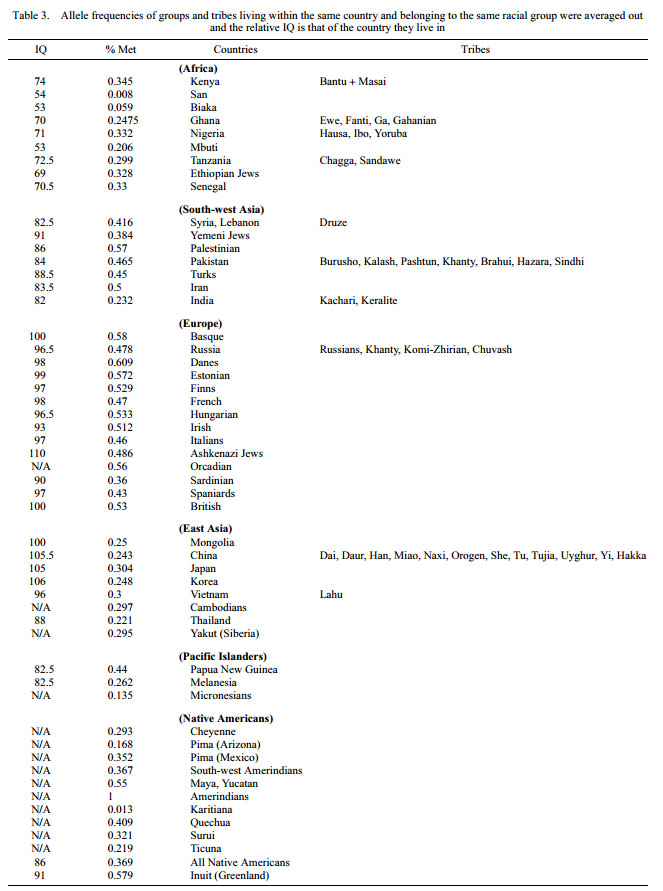Correlation of the COMT Val158Met Polymorphism with Latitude and a Hunter-Gather Lifestyle Suggests Culture–Gene Coevolution and Selective Pressure on Cognition Genes Due to Climate
Davide Piffer, Anthropological Science, July 31, 2013
Abstract
Dual-inheritance theory posits that the genotype has an impact on the evolution of human behavior and that cultural traits can be constrained by genetic imperatives. A large body of studies provides evidence that the functional catechol-O-methyltransferase (COMT) Val158Met polymorphism is associated with executive function, working memory (WM), and intelligence. A survey of the population genetics database provides evidence that COMT gene frequencies vary across populations. The aim of the present study was to test the hypothesis that the COMT gene has an impact on cultural evolution, specifically on the adoption of an agricultural vs. a hunter-gatherer lifestyle. Statistically significant differences in COMT allele frequencies between hunter-gatherer and agricultural societies were found. Ethnic groups whose economy is based on farming have higher frequencies of the Met allele (symbol: A), whereas societies based on a hunter-gatherer economy have very low frequencies of the Met allele and a disproportionate predominance of the Val allele. Moreover, the frequency of the Met allele was positively correlated to the populations’ IQ (r = 0.57). The FNBP1L gene (rs236330) is associated with childhood and adult intelligence and it varies in frequency across populations. Frequency of rs236330 was also significantly correlated with the populations’ IQ (r = 0.81). COMT and FNBP1L had fairly similar geographical distributions (r = 0.44) although the result did not reach statistical significance. The results suggest that the genotype of a population influences its cultural development in fairly specific and predictable ways. Met allele frequency was positively correlated with latitude (r = 0.56), suggesting selective pressure due to climate.
{snip}
Results
Hunter-gatherer and farming societies significantly differ in their COMT allele frequencies, confirming the prediction following from the hypothesis.
{snip}
Table 3 reports IQ and Met allele frequencies, taken from the Allele Frequency Database. IQs were taken from Lynn (2006), Lynn and Vanhanen (2012). Populations from the same country are grouped together and their average allele frequency is reported. The reported IQ refers to the average IQ for the country. Countries are grouped into racial groups or clusters as found in Cavalli-Sforza et al. (1994).
The correlation between IQ and Met frequencies for the global sample was computed. Due to unavailability of IQs for single Native American populations, their overall estimated IQ (86) was used (Lynn, 2006) and the allele frequencies of the different populations were averaged. Thus, the global correlation between IQ and Met allele frequency is r = 0.579 and highly statistically significant (n = 38; P < 0.001). This supports the prediction that populations with higher Met allele frequency have higher IQ, similarly to the correlation observed at the individual level.
{snip}
















